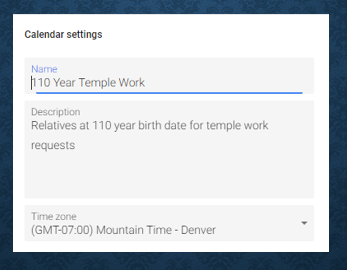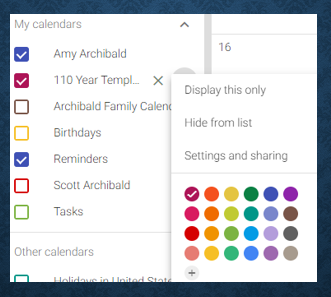As I work on adding, sourcing, and merging my family members in the FamilySearch Family Tree, I frequently add deceased family members who were born within the past 110 years.
In order to perform temple ordinances for your relative who was born less than 110 years ago, Church policy states, you must either be one of the closest living relatives, or you must obtain permission from one of the closest living relatives.
If I am not one of the closest living relatives or I have not yet found a closest living relative from whom I can obtain permission, I add this individual to my "110 Year Temple Work" calendar.
The day before the relative turns 110, I receive an email from my calendar notifying me of this event. I use that day to check to see if other relatives have added any additional sources or memories to the record since I worked on the record in the Tree. I also double check to see if there have been any duplicates of this person added to the Tree. If I find any duplicates, I verify they are the same person and then merge the records together.
At 12:00 am UTC on the day of the relative's 110th birthday, the temple ordinances (if any) become available to reserve without permission. UTC = Universal Time Coordinated or Coordinated Universal Time. It is a time standard associated with zero degree longitude and is the basis for time zones worldwide. GMT = Greenwich Mean Time is a time zone and shares the same current time as UTC.
Calendar Setup
I utilize a
Google Calendar for my 110 Year Temple Work Calendar.
Under Settings, I selected "Add Calendar" and then "New Calendar".
I named my calendar "110 Year Temple Work" and gave it a description and selected my time zone.
I currently share my calendar with my sister who is actively working on our shared family history. She is able to add any 110 year birthday to the calendar. In the future, we plan to share this calendar with the youth and young adults in our family. Some of the 110 year birthday events are many decades into the future and we want our family members to complete the work we have researched.
You can share your calendar with anyone and you can control the access they have to the calendar. See events only, or add/make changes are some of the access options.
When I create an event in the calendar, I select "All day". I'll explain more about this when I show you how to add an event to the calendar. However, in the calendar settings, I can choose how I want to receive notifications for "All day" events. I have chosen to be notified by email one day before the event at 9 am. My sister chooses to be notified the day of the event.
That is the basic setup for the calendar. The only other thing I've done with my calendar is choose the color of the event display. You can find this option, by viewing the calendar and in the left navigation bar, selecting the 3 vertical dot menu to the right of the calendar name.
Event Setup
There are 2 ways to create an event. Either double click the day on the calendar, or click the red + sign at the bottom right corner of the calendar page.
Under "Add title" I add the name of my relative and in parenthesis I include the Family Tree PID for that person. If I am adding names to the calendar from my husband's family, I also add my husband's name to the title. That would look like this: "Thomas Godderidge (L2PC-D8R) - Scott"
Next I select the "All day" box and then add the birth date of the relative + 110 years. In the example above, Bertha was born on September 10, 1908, so I set the date as September 10, 2018.
Then I make sure to select the 110 Year Temple Work calendar (since I have a few other Google calendars). Then I click on the Save button at the top right of the screen.
Back to the calendar page, I can click on the event on September 10 for Bertha and I see this pop-out card. This shows me the relative's name, FamilySearch PID, date of the 110 year birthday, the notification I have set (email) and that I created this event. Clicking the edit pencil below Bertha's name takes me back to the event setup screen if needed.
At the top of the calendar is a magnifying glass that provides a search of the calendar.
I can search the calendar for name of the relative (full name, first name, last name), the FamilySearch PID, and I can even filter out my husbands family by searching for "- Scott". Here is a section of the calendar a few years out.
So what about relatives where I only know a birth year or a birth month/year, but don't know the specific date? The Church policy for requesting ordinances is the end of that birth year or the end of the month of that birth month/year.
For a birth in October 1924, I create an event for October 31, 2034.
For a birth in 1930, I create an event for December 31, 2040.
I have also in the past created events for the beginning of those month/years or years.
For an example: Birth in 1914, I may create an event for January 1, 1924. Then I spend time researching that relative again to see if I can find a more specific date with newer available records since my older research. If I can, I change the event to that specific date. If I cannot, I change the event to the end of the year.
And sometimes I look ahead in the calendar to the end of a month or end of a year to see if there are individuals I can revisit with my research.
Event Notification
This is what the email looks like when I get notified of a 110th birthday.
***
This has been a great solution for my needs. I am able to keep track of all the relatives I add to the Family Tree who still need temple work; which I don't yet have permission to do. When I get an email of their 110th birthday it is a powerful reminder of the temple ordinances that may still need to be offered for this relative. As I finish the final preparations to their Family Tree record, oftentimes the spiritual impressions are so very powerful. I literally know of my relative's preparedness to receive temple ordinances.
Do you have any questions or additional suggestions?
How about you? Will this work for you?
Please leave a comment below - I'd love to hear your thoughts and ideas.














